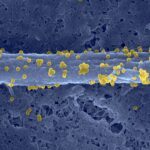Link to Pubmed [PMID] – 31554973
Link to DOI – 10.1038/s41586-019-1578-4
Nature 2019 Oct; 574(7777): 259-263
Chikungunya virus (CHIKV) is a re-emerging alphavirus that is transmitted to humans by mosquito bites and causes musculoskeletal and joint pain1,2. Despite intensive investigations, the human cellular factors that are critical for CHIKV infection remain unknown, hampering the understanding of viral pathogenesis and the development of anti-CHIKV therapies. Here we identified the four-and-a-half LIM domain protein 1 (FHL1)3 as a host factor that is required for CHIKV permissiveness and pathogenesis in humans and mice. Ablation of FHL1 expression results in the inhibition of infection by several CHIKV strains and o’nyong-nyong virus, but not by other alphaviruses and flaviviruses. Conversely, expression of FHL1 promotes CHIKV infection in cells that do not normally express it. FHL1 interacts directly with the hypervariable domain of the nsP3 protein of CHIKV and is essential for the replication of viral RNA. FHL1 is highly expressed in CHIKV-target cells and is particularly abundant in muscles3,4. Dermal fibroblasts and muscle cells derived from patients with Emery-Dreifuss muscular dystrophy that lack functional FHL15 are resistant to CHIKV infection. Furthermore, CHIKV infection is undetectable in Fhl1-knockout mice. Overall, this study shows that FHL1 is a key factor expressed by the host that enables CHIKV infection and identifies the interaction between nsP3 and FHL1 as a promising target for the development of anti-CHIKV therapies.

